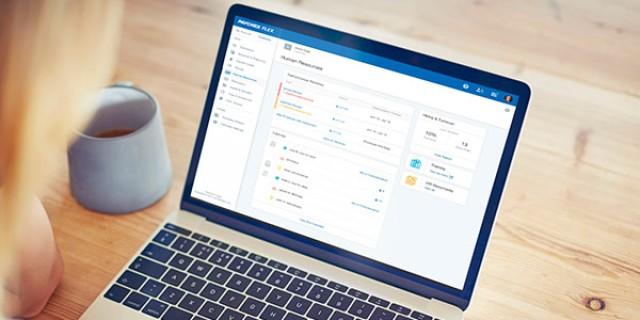- HCM
- Article
- 6 min. Read
- Last Updated: 11/20/2025
9 HR Technology Trends Transforming Businesses in 2026

Table of Contents
The HR technology landscape is expected to shift dramatically in 2026. As AI, flexible work, and evolving analytics models become mainstream, HR teams need practical strategies for investing in workplace development and efficiency. While it's impossible to know precisely what the future of human resources looks like, HR trends in 2026 emphasize using AI to streamline and automate repetitive work, solving complex challenges with strategic technology implementation, and increasing efficiency to develop a skilled and empowered workforce.
Below, we identify some of the most pressing HR technology trends that are likely to shape the future of HR in 2026 and beyond.
What Is HR Technology?
HR technology encompasses hardware, software, online platforms, mobile applications, and tools used to support human resource tasks and responsibilities. Payroll, employee benefits, recruiting, and applicant tracking are just a few examples. More recent developments in HR technologies help address a broader range of challenges — everything from platforms to support remote and hybrid work environments to using artificial intelligence (AI) and intelligent analytics.
An increasingly competitive marketplace, coupled with advancements in AI and analytics, has helped to fuel this surge in HR technology advancement. In addition, businesses can use more online resources and technological innovations to boost efficiency and adapt to changing employee and customer expectations.
HR Technology Boosts Efficiency
Efficiency is not optional in today’s workforce. “Everybody's being challenged to do more with less,” says Nathan Shapiro, Sr. Director of Digital Platform & User Experience at Paychex. "Whether you're an owner-operator, a frontline leader, or a CHRO, there's a desperate need for greater efficiency to get out of the back office and admin."
Many of this year’s trends in HR tech focus on using AI to streamline or automate more of this back-office work. For example, AI can help businesses:
- Manage compliance with applicable employment laws and regulations
- Make informed decisions about hiring, engagement, and benefits
- Automate repetitive tasks
- Evaluate and approve timesheets
- Identify and analyze workforce trends like retention and turnover
- Process payroll for employees
- Maintain up-to-date employee information
- Communicate quickly to employees about time-sensitive information
- Address complex challenges like work-life balance, performance management, and strategic decision-making
Why HR Technology Matters in 2026
Competitive pressures in today’s market have made strategic use of HR technology a critical business priority. As AI matures and enterprise-grade technology becomes more accessible, technology can help businesses address the demands of recruiting, remote work expectations, and employee needs.
HR technology can help solve key challenges in the following five areas:
- Workforce Management: The workforce drives the business, meaning that your people are your most important asset. Effective workforce management is mission-critical, whether it's recruiting, onboarding, performance management, or retention.
- Efficiency: In today’s business environment, efficiency is not optional. From the C-suite to the newest hire, improving efficiency is a key way to achieve better outcomes and get more done with fewer resources.
- Increasing Complexity: An increasingly complex web of challenges calls for various parts of the business to work together strategically. The right technology can break down silos between departments, so you can better address challenges across HR, IT, Finance, and Operations.
- Lack of Experience: Tools alone can't solve problems created by a lack of expertise. In fact, tools like AI can magnify dangerous behavior in the hands of an inexperienced user. Rather than blindly turning to a tool like ChatGPT, employees need access to someone with AI literacy and subject matter expertise to teach them how to use those tools safely and effectively.
- Lack of Integration: Lack of technology integration across HR, finance, sales, and operations can create cost inefficiencies. Building an ecosystem of trusted partners can help bridge those gaps and align resources around organizational goals.
9 Trends in HR Technology for 2026
As we look ahead to 2026, technology trends in HR point to solutions that embrace the responsible use of AI, center the employee experience, and do more with less. HR is no longer merely a back-office function. The goal is to prioritize human connection by using technology to automate and streamline back-office tasks while freeing humans to effectively manage the workforce.
For 2026 and beyond, HR and technology trends anticipate:
- AI-powered HR transformation
- Responsible use of generative AI
- Employee experience focus
- Predictive people analytics and data-driven decision-making
- Flexible work models and hybrid work technology
- Cybersecurity and data privacy
- Skills-based talent management and learning
- Contingent workforce integration
- Trusted partner ecosystems
1. AI-Powered HR Transformation
As AI has evolved, so has its potential to transform the workplace. According to the 2026 Business Leaders Priorities survey, 33% of businesses find AI adoption extremely challenging, but those who automate can gain a competitive advantage. AI applications can reduce that workload by automating repetitive tasks to increase productivity, minimize mistakes, and reduce manual back-office work so humans can focus on connection and people management. Underlying all of these goals is an urgent need for greater efficiency to remain competitive in an uncertain economy.
The power of AI lies in its ability to support human workers, helping them get more done in less time. HR professionals can use it to automate tasks, provide proactive recommendations in the flow of work, deliver embedded insights, and create personalized solutions. Here are three examples of AI in action:
- Personalized Learning Experiences: AI can create personalized learning paths for employees based on their role, current credentials, skill gaps, and other data. This capability can help streamline onboarding, upskill workers for new technology, or train the next generation of leaders.
- Timesheet Scoring and Approval: AI time and attendance tools can evaluate timecards and score them so managers can immediately see what needs attention. Rather than having to inspect every line on every time card, managers can configure the platform to quickly identify behavioral trends and ensure payroll accuracy.
- Recruiting and Hiring: AI tools can help streamline the recruitment process by pre-screening, scheduling interviews, and personalizing the candidate experience. HR leaders can also use an applicant tracking system to add automation to resume screening and responsibly assess candidate fit.
Potential applications for AI are endless. The bottom-line benefits, however, are greater efficiency, reduced costs, and better employee experiences.
2. Responsible Use of Generative AI
Generative AI deserves its own discussion, because it has transformed the way we work. Many productivity platforms have GenAI built into their interfaces, and employees can tap into them to help with writing content, creating images, assessing data, and much more. GenAI and AI agents help free up capacity so human workers can focus attention on their areas of expertise, improve efficiency, and deliver greater overall benefits for the business.
While these tools offer undeniable increases in productivity, the trend in 2026 will be on using them ethically, accurately, and safely. John Phillips, VP and GM at Findem says, “We see AI as an assistant; we don't see it as a decision-maker. And those are really important things as we go to market. It's really around accuracy of connection.”
Companies using AI should set guidelines and train employees to use AI responsibly and to recognize the limitations of GenAI tools and AI agents, including:
- Inaccurate or inconsistent outputs (e.g., hallucinations) or outdated information and statistics
- Security risks for intellectual property and privacy
- Potential bias if data is not diverse and if GenAI models are not continuously evaluated
- Ethical concerns about copyrighted material, use of images without permission (e.g., deepfakes), and misrepresentation of viewpoints or personal information
- Rapidly evolving AI regulations and compliance challenges
- Leaning too heavily on AI agents without sufficient guidance on when and how they can act on your behalf
3. Employee Experience Focus
From the candidate process to well after an employee's last days on the job, the employee experience (EX) includes every touchpoint and interaction with your company. Managing these interactions well can help you retain top talent, boost engagement, and reach peak productivity.
Employee experience technology, or EX tech, can enhance every touchpoint in the employee lifecycle, from recruitment to offboarding. Here are some ways you can put it to work:
- Personalized Recruiting Experiences: Use AI to create personalized messages for candidates based on where they are in the recruitment process. This keeps candidates engaged and presents your company culture as a welcoming, positive environment.
- New-Hire Training and Onboarding: Creating a positive experience when onboarding an employee can favorably affect workplace efficiency, accelerate training and development, and help drive results in a healthier, more collaborative company culture. During the onboarding process, use your HCM (Human Capital Management) platform to automate task lists and reminders, create a central location for training information and resources (including your employee handbook), and create feedback loops to monitor progress. You can also implement AI-powered chatbots to guide new employees and help answer questions.
- Benefits Offerings: To remain competitive, you may need to rethink your benefits programs. Technology in HR can help you identify benefits that resonate most with today's job candidates and rapidly compare benefit program costs and offerings. It can also help support your employees’ benefits selection and enrollment.
- Employee Training: Offer training opportunities through learning tools and technologies, industry conferences, or online training resources. Microlearning modules for in-the-moment training and virtual reality scenarios for skills training can also help employees prepare for future career growth.
- Employee Wellbeing: Every employee deserves a safe and healthy work environment. Programs addressing physical needs, mental health, and work-life balance for in-person workers, remote workers, and those on a flexible work schedule can go a long way toward keeping employees engaged and productive. Start by allocating benefit dollars toward resources such as an employee assistance program (EAP), mental health services, and digital coaching platforms. Monitor employee well-being through surveys, polls, and focus groups, prioritize policies that protect against burnout, and use tools to monitor hours worked, breaks, and PTO. Remote and distributed workers may need social connection tools to maintain a sense of inclusion and belonging with colleagues.
4. Predictive People Analytics & Data-Driven Decision Making
Analytics tools help HR teams make informed decisions about hiring, engagement, and benefits, especially in small and mid-sized businesses. By extracting key insights and identifying trends, they can help leaders predict turnover, optimize staffing, and demonstrate ROI. They can also help pinpoint underlying reasons for the trends you’re seeing.
Companies that invest in HR analytics now can create a solid foundation to make data-driven decisions about hiring, staffing, benefits administration, employee engagement, and much more in 2026. Investment in data analytics technology can also demonstrate the value of human resources as part of an effective, forward-thinking HCM strategy.
5. Flexible Work Models and Hybrid Work Technology
Despite the recent cluster of return-to-office policies, remote work remains strongly preferred by many employees. Nearly half of employees who work remotely at least part-time say they would be unlikely to stay with an employer if they were no longer able to work from home. Location flexibility, hybrid work, and flex scheduling can help retain these workers while boosting employee engagement, productivity, and retention.
Building thriving remote and hybrid work models includes investing in technology tools that foster collaboration, communication, and connection among team members. These tools help businesses maintain productivity and employee satisfaction in flexible environments. Managers can use them to create team-building opportunities, monitor progress, and provide coaching and feedback. In addition, a feature-rich HCM platform can help you conduct onboarding and training, oversee performance management, and keep lines of communication open between employees and HR.
Flexible work can also be a key differentiator in talent acquisition and retention. With fewer fully remote jobs available in recent months, the demand for those roles has surged. With 90% of HR leaders focused on employee engagement and retention, remote work may be a key way to maintain competitive advantage as an employer of choice.
6. Cybersecurity & Data Privacy
As digital HR systems become standard in many organizations, data privacy, encryption, and employee training to protect sensitive information have become high-priority issues. According to our 2025 Priorities for Business Leaders survey, the top technology obstacle on business leaders' radar is data security and employee data privacy (56%).
Safeguarding employee data, complying with regulatory guidelines, and maintaining a strong cybersecurity posture require increasing vigilance as HR departments adopt new technology. Here are some critical areas to consider:
- Compliance With Privacy Laws: Ensure compliance with national and international laws and regulations such as the General Data Protection Regulation (GDPR) and the California Consumer Privacy Act (CCPA). These laws govern how personal data may be used and protect individual rights to privacy and security.
- Identity and Access Management (IAM): IAM tools manage password credentials, digital identity, and access rights to ensure that only authorized individuals can access your company network and data.
- Data Encryption: Encryption ensures that information is kept private as it travels over the network. Use encryption technology to secure devices, protect personal and financial data, and safeguard virtual private networks (VPN).
- Cybersecurity Training: Implement training for all personnel, including senior executives, to raise awareness. Training can include policies, response guidelines, and exercises to better prepare employees for identifying potential AI-driven social-engineering attacks.
7. Skills-Based Talent Management & Learning
New performance management techniques are transforming the way businesses prioritize their retention efforts. For instance, investing in professional development can help employees sharpen skills in critical areas and show a commitment to prioritizing their career growth. Upskilling (training that builds upon an employee's current skills) and reskilling (training an employee for an entirely different job) programs can be worthwhile investments in your company's future, your employees' success, and in individual career paths.
Offering development opportunities through learning management software and in-the-moment training modules helps you create a sustainable workforce and encourages employees to grow within the organization.
8. Contingent Workforce Integration
The contingent workforce includes independent contractors, temporary workers, freelancers, consultants, agency workers, and others who provide services for your company in a non-traditional capacity. Many organizations hire these workers for non-core tasks like content development, graphic design, IT services, software implementations, and accounting.
Contingent workers are an extension of your workforce, and the right technology tools can help them remain connected and integrated with your team. Shapiro notes, “As gig and freelance work expands, HR platforms are evolving to support communication, integration, and compliance for non-traditional workers.” Communication and chat tools, project management platforms, vendor management systems, and even specialty platforms designed for contingent workers may be wise investments to improve efficiency and productivity.
9. Trusted Partnership Ecosystems
As work environments become more fluid, companies should seek out high-performing strategic partners with access to ecosystems, such as financial or accounting partners like CPAs and brokers. Your partner ecosystem also includes integrated HCM applications that connect payroll, HR, benefits, time tracking, accounting, and other systems. Unified platforms with robust API connectivity and third-party integrations help eliminate data silos, manual re-entry, and disconnected workflows.
These strategic partnerships allow companies to be more proactive in seeking solutions that create impacts beyond the bounds of the traditional HCM.
How To Prepare Your Organization for 2026 HR Tech Trends
As you consider your HR technology needs for 2026, a phased implementation approach will help you get the most out of new technology, minimize disruption, and teach employees how to use new tools effectively. Here’s a simple framework to help you design your implementation roadmap:
- Assess: Assess the current state of your HR technology to identify gaps and opportunities. Conduct an inventory of existing systems, pinpoint process bottlenecks or productivity challenges, and survey employees about workflow issues. With this information, you can determine what kinds of technology you should invest in, whether that’s a new HCM or an AI tool to automate repetitive processes.
- Prioritize: Build a prioritization framework to help you decide which trends to tackle first. Consider your business size, industry, most urgent pain points, and budget constraints. Many small businesses will benefit most by starting with compliance automation and an employee experience platform to streamline the HR administrative burden.
- Pilot: Introduce your team to the new technology gradually. Pilot the platform with a small group first and gather their feedback about the process and user experience. Use that information to refine configurations and workflows before scaling to the full organization.
- Scale: When you’re ready to roll out the new technology to your entire team, you’ll need a strong change management strategy that ensures stakeholder buy-in and improves adoption rates among employees. Communicate a clear need for the change, get support from leaders, and build out a communication strategy that answers employee questions and shows them how the new technology will make their work easier, faster, or more effective. Use hands-on training, power users and champions who can advocate and answer peer questions, and provide ongoing support as needed.
- Optimize: Monitor key metrics like time saved, error reduction, and compliance incident reduction, and survey employees for feedback to fine-tune processes. Ultimately, the true test of success is whether the technology helps you achieve your organizational goals, whether that’s reducing administrative workload, improving employee retention, or filling open roles faster.
Investment & Budget Planning for HR Technology
As you determine your HR technology budget, start with a cost/benefit analysis that considers not only the dollars you spend, but also the expected return on investment from improving productivity and efficiency and the cost of not taking action. For example, the 2025 Priorities for Business Leaders survey found that companies spend an average of $171,997 on HR tasks every year. For companies with between 100 and 500 employees, that annual cost jumps to $413,804. HR technology can help drive down those costs by automating tasks, reducing errors, and minimizing the need for manual data entry.
As you crunch the numbers, consider these factors:
- Typical Costs for Common HR Tasks: The following numbers are average annual costs for the most time-consuming HR tasks based on the 2025 Priorities for Business Leaders survey:
- Payroll Processing: $23,940
- People Management: $19,202
- Tracking Hours Worked: $17,605
- Measuring and Managing Performance: $14,190
- Recruiting and Onboarding: $14,086 (not counting the recruiting costs themselves)
- ROI Metrics: How will the new technology affect key metrics such as cost savings, time savings, accuracy improvements, retention and turnover, compliance incidents, and productivity?
- Payback Period: How long will it take for the new technology to pay for itself? You can calculate this number by comparing current costs with expected savings based on projections. In most cases, you can expect a payback period of 12-18 months.
- Build/Buy/Outsource: Is it most effective to build custom technology for your needs, to use a SaaS platform, or to outsource some or all of your HR tasks to a professional employer organization (PEO)?
- Total Cost of Ownership: How much will it cost to implement and maintain the technology, including subscription fees, license fees, implementation support, integration with current systems, training, ongoing maintenance, and future upgrades?
A SaaS platform subscription fee usually includes many of the associated costs of owning and maintaining technology and includes support at some level. This is often the best solution for small to mid-size businesses looking to improve efficiency and productivity.
Transform HR With Technology in 2026
Investing in these HR tech trends for 2026 can help you simplify complex HR admin functions, improve efficiency, and give your HR team more time to focus on what matters most: your people. Paychex can help your business align with emerging trends in human resources and develop a thriving workplace.
Tags








